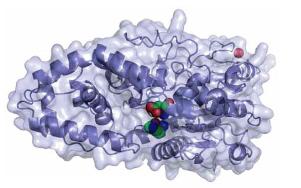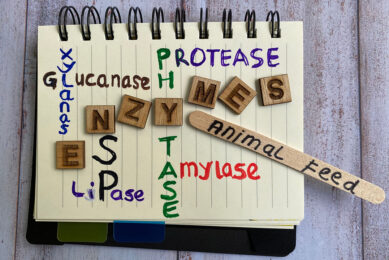How to value lucrative enzymes in linear programming

Enzymes have become a key solution in resource efficiency. Phytase is known to raise the available or digestible phosphorus. However, the power to release digestible P out of plant phytate is not linear. This means that it’s no use adding (expensive) phytase to the feed unlimitedly. But how to deal with this non-linear effect? How to obtain the most cost-effective use of enzymes in your formulation?
In modern feed formulation the main question is: How can I easily formulate the cheapest compound with the most optimal inclusion of enzymes? Formulation managers have an increasingly strategic role to play in a complex market. Resource efficiency has become a key word in feed formulation. Breaking down the plant phytate to release more digestible Phosphorus (P) by adding phytase in animal feed has become common practice.
However, the non-linear behaviour of phytase (Figure 1) means a challenge for feed formulation programs. How useful adding phytase to feed may seem, tests have shown that the power to release digestible P out of plant phytate is not linear. This means that the first 250 units of phytase (FTU) will release more digestible P than the second 250 FTU you include in a compound.
Phosphorus fractions within diet
The total phosphorus in the diet is composed of fractions with variable bioavailability. The addition of phytase creates an additional pool of available phosphorus from phytic acid, increasing the total pool of non-phytate P available to the animal (Figure 2).
The total phosphorus in the diet is composed of fractions with variable bioavailability. The addition of phytase creates an additional pool of available phosphorus from phytic acid, increasing the total pool of non-phytate P available to the animal (Figure 2).
This ‘non-linear behaviour’ forms special challenges for feed formulation programs, as these are based on linear programming. Adifo’s least-cost feed formulation program Bestmix is a new tool that offers a sound solution for optimising with “non-linear” effect. The software breaks down the effect of phytase into linear phases to simulate the non-linear effect. This way, the formulator can apply phytase as if it were any other ingredient, resulting in the same values: the optimal inclusion rate, the shadow price, the total consumption, etc. Bestmix uses a full optimisation, resulting in a dynamic inclusion rate of phytase and the lowest possible compound price.
There is more. The program also gives insight in the behaviour of the enzyme in the composition. It compares the composition and the price of the compound twice: Once with the use of phytase and once without the use of phytase. This way, the nutritionist can analyse the behaviour of phytase in all details.
Anti-nutritional effect of enzymes
Phytase not only releases extra digestible phosphorus. Due to its anti-nutritional effect of phytate, the enzyme also raises the level of protein, amino-acids and energy values in the feed. If phytase is added to the feed, more digestible P will become available. An additional effect of adding phytase is that more energy and amino acids will be available to the animal. This has to do with neutralisation of the anti-nutritional effect of phytate in the feed. The software clearly shows to the nutritionist the effect of phytase in the compound feed for all nutrients. These extra advantages are made visible in Bestmix.
Phytase not only releases extra digestible phosphorus. Due to its anti-nutritional effect of phytate, the enzyme also raises the level of protein, amino-acids and energy values in the feed. If phytase is added to the feed, more digestible P will become available. An additional effect of adding phytase is that more energy and amino acids will be available to the animal. This has to do with neutralisation of the anti-nutritional effect of phytate in the feed. The software clearly shows to the nutritionist the effect of phytase in the compound feed for all nutrients. These extra advantages are made visible in Bestmix.
Not all phytases available on the market have the same effectiveness, or the same price. With the new module it is easy to evaluate every single type of phytase, making it clear which phytase brings the highest value to your specific compound.
The feed formulation software not only offers a solution for working with phytase, but also with any kind of NSP enzyme. This means the formulator can set up a NSP-enzyme in such a way, that its effect on the nutritional value of certain other ingredients is defined. In other words, the nutritionist defines exactly on which ingredients the enzyme has an actual effect. This way, the ingredient matrix is kept clean. It has proven to be a far better solution than to create different series of a certain ingredient, with adapted nutrient values for every NSP enzyme and every possible enzyme activity combination.
Phytase quick facts • Phytase is an enzyme that increases availability of P in animal diets. • Phytase lowers the amount of supplemental P required in the diet. • Because of improved dietary P utilisation, less P is excreted in the manure. • Some ingredients possess intrinsic phytase activity. Corn and soybean meal contain negligible levels of phytase activity. Wheat contains considerably higher levels of intrinsic phytase. • Intrinsic phytase activity may be lost when ingredients are subjected to high temperatures, such as during the pelleting process. • Commercially available exogenous phytases are commonly derived from either fungi or bacteria, such as Aspergillus niger and Escherichia coli, but can also be expressed in yeasts. • Phytase derived from E coli bacteria is more efficacious than fungal phytases in terms of the amount of phosphorus released per unit of phytase. • Depending on the assay used, different results of phytase activity may be reported. • Heat-stable phytases are available. • Phytase products should be stored only in cool, dark, dry areas, especially when phytase is included in vitamins and trace-mineral premixes. |











